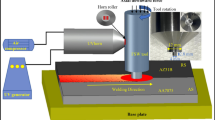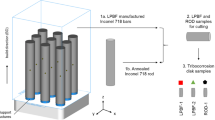Abstract
A new spot joining process called dieless friction stir extrusion is proposed, in which simultaneous mechanical interlocking (collar formation) and metallurgical bonding is the key aspect of joint formation. The pinless flat stir tool eliminates pinhole and hook formation, the common defects of friction stir spot welding. Aluminum alloy sheets such as AA 5052-H32 and AA 6061-T6 are spot joined and the effect of change in tool shoulder diameter (10–18 mm) on joint strength and joint formation is evaluated. Lap shear fracture load of 6.22 kN obtained at optimum tool shoulder diameter of 14 mm is higher than that of conventional spot joining techniques. Macrostructure analysis revealed that increase in tool shoulder diameter results in poor mechanical interlocking. Consequently, pin shear failure is common at highest tool shoulder diameter. Critical weak zones of failure are identified. The change in tool shoulder diameter has significant impact on the external joint morphology.
Similar content being viewed by others
References
G. S. Cole and A. M. Sherman, Lightweight materials for automotive applications, Mater. Charact., 35 (1) (1995) 3–9.
M. Haghshenas and A. P. Gerlich, Joining of automotive sheet materials by friction-based welding methods: A review, Eng. Sci. Technol. Int. J., 21 (1) (2018) 130–148.
K. Chen, X. Liu and J. Ni, Keyhole refilled friction stir spot welding of aluminum alloy to advanced high strength steel, J. Mater. Process. Technol., 249 (2017) 452–462.
W. Y. Li, Q. Chu, X. W. Yang, J. J. Shen, A. Vairis and W. B. Wang, Microstructure and morphology evolution of probeless friction stir spot welded joints of aluminum alloy, J. Mater. Process. Technol., 252 (2018) 69–80.
W. T. Evans, B. T. Gibson, J. T. Reynolds, A. M. Strauss and G. E. Cook, Friction stir extrusion: A new process for joining dissimilar materials, Manuf. Lett., 5 (2015) 25–28.
S. Lazarevic, S. F. Miller, J. Li and B. E. Carlson, Experimental analysis of friction stir forming for dissimilar material joining application, J. Manuf. Process., 15 (2013) 616–624.
S. Lazarevic, K. A. Ogata, S. F. Miller, G. H. Kruger and B. E. Carlson, Formation and structure of work material in the friction stir forming process, J. Manuf. Sci. Eng., 137 (5) (2015) 1–9.
T. P. Saju and R. G. Narayanan, Friction stir forming of dissimilar grade aluminum alloys: Influence of tool rotational speed on the joint evolution, mechanical performance, and failure modes, Int. J. Adv. Manuf. Technol., 95 (1–4) (2017) 1377–1397.
T. P. Saju and R. G. Narayanan, Effect of tool plunge depth on joint formation and mechanical performance of friction stir forming joints made between AA 5052-H32 and AA 6061-T6 sheet metals, T. Nonferr. Metal Soc., 28 (4) (2018) 613–628.
Z. Liu, H. Cui, S. Ji, M. Xu and X. Meng, Improving joint features and mechanical properties of pinless fiction stir welding of Alcald 2A12-T4 aluminum alloy, J. Mater. Sci. Technol., 32 (12) (2016) 1372–1377.
A. Reilly, H. Shercliff, Y. Chen and P. Prangnell, Modelling and visualization of material flow in friction stir spot welding, J. Mater. Process. Technol., 225 (2015) 473–484.
M. Paidar, A. Khodabandeh, H. Najafi and A. S. Rouhaghdam, Effects of the tool rotational speed and shoulder penetration depth on mechanical properties and failure modes of friction stir spot welds of aluminum 2024-T3 sheets, J. Mech. &c. Tech., 28 (12) (2014) 4893–4898.
M. Paidar, A. Khodabandeh, M. L. Sarab and M. Taheri, Effect of welding parameters (plunge depths of shoulder, pin geometry, and tool rotational speed) on the failure mode and stir zone characteristics of friction stir spot welded aluminum 2024-T3 sheets, J. Mech. &c. Tech., 29 (11) (2015) 4639–4644.
M. Paidar and M. L. Sarab, Friction stir spot welding of 2024-T3 aluminum alloy with SiC nanoparticles, J. Mech. &c. Tech., 30 (1) (2016) 365–370.
C. S. Jeon, Y. H. Jeong, S. T. Hong, M. T. Hasan, H. N. Tien, S. H. Hur and Y. J. Kwon, Mechanical properties of graphite/aluminum metal matrix composite joints by friction stir spot welding, J. Mech. &c. Tech., 28 (2) (2014) 499–504.
Y. Tozaki, Y. Uematsu and K. Tokaji, A newly developed tool without probe for friction stir spot welding and its performance, J. Mater. Process. Technol., 210 (2010) 844–851.
Y. C. Chen, S. F. Liu, D. Bakavos and P. B. Prangnell, The effect of a paint bake treatment on joint performance in friction stir spot welding AA6111-T4 sheet using a pinless tool, Mater. Chem. Phys., 141 (2–3) (2013) 768–775.
A. Garg and A. Bhattacharya, Similar and dissimilar joining of AA6061-T6 and copper by single and multi-spot friction stirring, J. Mater. Process. Technol., 250 (2017) 330–344.
Standard Test Methods for Tension Testing of Metallic Materials, ASTM E8/E8M-09 (2009).
Standard Test Method for Plastic Strain Ratio r for Sheet Metal, ASTM E517 (2010).
Recommended Practices for Test Methods for Evaluating the Resistance Spot Welding Behavior of Automotive Sheet Steel Materials, ANSI/AWS D8. 9–97 (1997).
Standard Practice for Microetching Metals and Alloys, ASTM E407–07 (2007).
Standard Test Methods for Determining Average Grain Size, ASTM E112–13 (2013).
Standard Test Methods for Vickers Hardness and Knoop Hardness of Metallic Materials, ASTM E92–16 (2016).
M. Awang and V. H. Mucino, Energy generation during friction stir spot welding (FSSW) of Al 6061-T6 plates, Mater. Manuf. Process., 25 (1–3) (2010) 167–174.
Acknowledgements
The authors thank the friction stir welding setup extended by NIT Agartala and the mechanical testing facility extended by Central Instruments Facility, IIT Guwahati. This research did not receive any specific grant from funding agencies in the public, commercial, or not-for-profit sectors.
Author information
Authors and Affiliations
Corresponding author
Additional information
Recommended by Associate Editor Young Whan Park
Tinu P Saju is a Ph.D. research scholar from Indian Institute of Technology, Guwahati, India. His area of research includes novel friction stir based joining techniques such as friction stir spot welding, dieless friction stir forming and conventional friction stir forming of lightweight sheet metals such as aluminum alloys.
R. Ganesh Narayanan is an associate professor at the Department of Mechanical Engineering, IIT Guwahati, India. His research interests include metal forming and joining. He has contributed many research articles in reputed journals and international conferences. He has edited few books including ‘Strengthening and Joining by Plastic Deformation’ published by Springer Singapore, ‘Advances in Material Forming and Joining’ published by Springer India, and ‘Metal Forming Technology and Process Modeling’ published by McGraw Hill Education, India. He has also edited special issues in the International Journal of Mechatronics and Manufacturing Systems, and in the Journal of Machining and Forming Technologies.
Barnik Saha Roy obtained his Ph.D. degree in the year 2016. He is currently an assistant professor in Mechanical Engineering Department at National Institute of Technology Agartala. His main areas of research are modelling and analysis of welding processes, optimization techniques in welding, characterization study. His research interests include modelling of friction stir welding process, optimization of heat generated during welding processes, optimization of process parameters for achieving desired mechanical properties during welding processes. He has authored five research papers in international journal, six in international conferences, one in national conference, three book chapters and one book to his credit.
Rights and permissions
About this article
Cite this article
Saju, T.P., Narayanan, R.G. & Roy, B.S. Effect of pinless tool shoulder diameter on dieless friction stir extrusion joining of AA 5052-H32 and AA 6061-T6 aluminum alloy sheets. J Mech Sci Technol 33, 3981–3997 (2019). https://doi.org/10.1007/s12206-019-0136-1
Received:
Revised:
Accepted:
Published:
Issue Date:
DOI: https://doi.org/10.1007/s12206-019-0136-1




